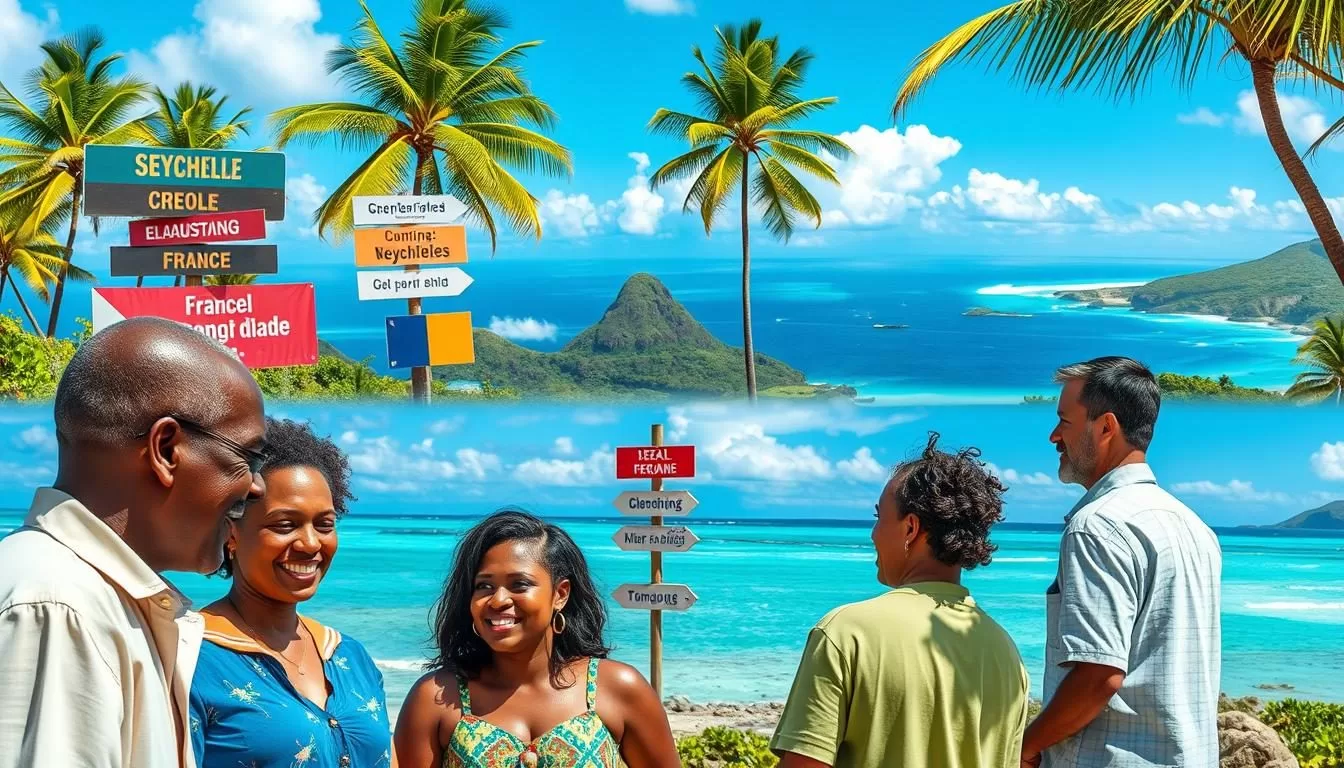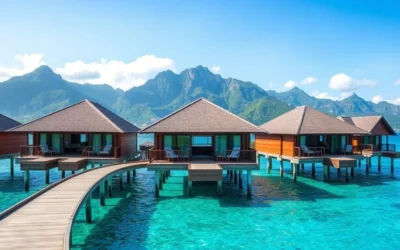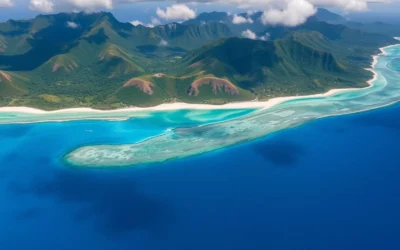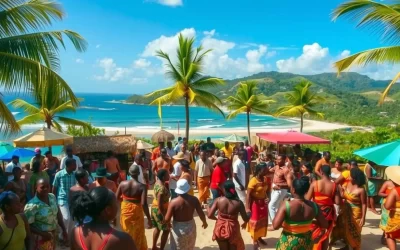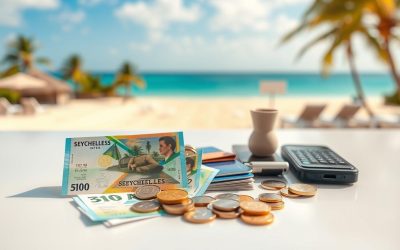✓ Accommodations✓ Flights✓ Rental Cars✓ Tours & Activities
Welcome to the vibrant linguistic world of this island nation. Here, three official languages—Seychellois Creole, English, and French—shape daily life and culture. Seychellois Creole stands out as the heart of communication, spoken natively by approximately 95% of the population.
This language has deep roots in the country’s history. Adopted after independence in 1975, it reflects the blend of colonial and post-colonial influences. Its French base connects it to the Bourbonnais Creole group, making it unique yet familiar to some visitors.
English and French also play significant roles. English remains essential in government and business, while French is cherished by the Franco-Seychellois minority. Together, these languages create a rich tapestry that defines the country’s identity.
Overview of Seychelles’ Linguistic Landscape
Discover the diverse linguistic fabric of this island nation. Here, three official languages—Seychellois Creole, English, and French—play a vital role in shaping the culture and daily interactions. This unique blend reflects the country’s rich history and multi-ethnic influences.
Demographic Insights and Language Distribution
Approximately 95% of the population speaks Seychellois Creole as their native tongue. This language is deeply rooted in the island’s identity, serving as the primary mode of communication. English and French are also widely used, especially in formal settings like government and business.
The country’s demographic makeup further highlights its linguistic diversity. Most residents are of Creole descent, with minority groups from French, Indian, Chinese, and Arabic origins. This mix contributes to the vibrant cultural tapestry that defines the islands.
The Multi-Ethnic Tapestry
The population of this island nation is a melting pot of cultures. African, European, and Asian influences have shaped its language and traditions over the years. Seychellois Creole, with its French base, is a testament to this blend.
Historical events, such as colonial rule and the abolition of slavery, have played a significant role in shaping the country’s demographics. Today, this multi-ethnic heritage is celebrated through festivals, music, and daily life.
Historical Evolution of Seychelles Languages
The linguistic history of this island nation is a fascinating journey through time. Over the centuries, its language landscape has been shaped by colonial powers, cultural exchanges, and pivotal historical events.

Colonial and Post-Colonial Influences
Portuguese explorers were the first Europeans to land on these islands in the early 16th century. However, it was the French who established the first permanent settlement in 1770, bringing their language and culture.
Under French rule, the foundation for Seychellois Creole was laid. This language emerged as a blend of French and African dialects, primarily spoken by the slave population.
British colonization in the 19th century introduced English, which became integral to governance and education. Despite this, French influences remained strong, shaping the unique linguistic identity of the country.
The Journey to Independence and Language Officiality
Independence in 1976 marked a turning point for the island nation. Seychellois Creole was recognized as an official language, alongside English and French.
The establishment of the Creole Institute (Lensiti Kreol) in the same year played a crucial role in codifying and preserving the language. This move solidified its status as a symbol of national identity.
Today, the linguistic heritage of the island reflects its rich history. From colonial influences to post-independence reforms, every year has contributed to the vibrant language tapestry you see today.
Seychelles: Official and widely spoken languages
The linguistic diversity of this island nation is a reflection of its rich cultural heritage. Here, three languages—Seychellois Creole, English, and French—shape daily life and formal interactions. Each plays a distinct role in the country’s identity.
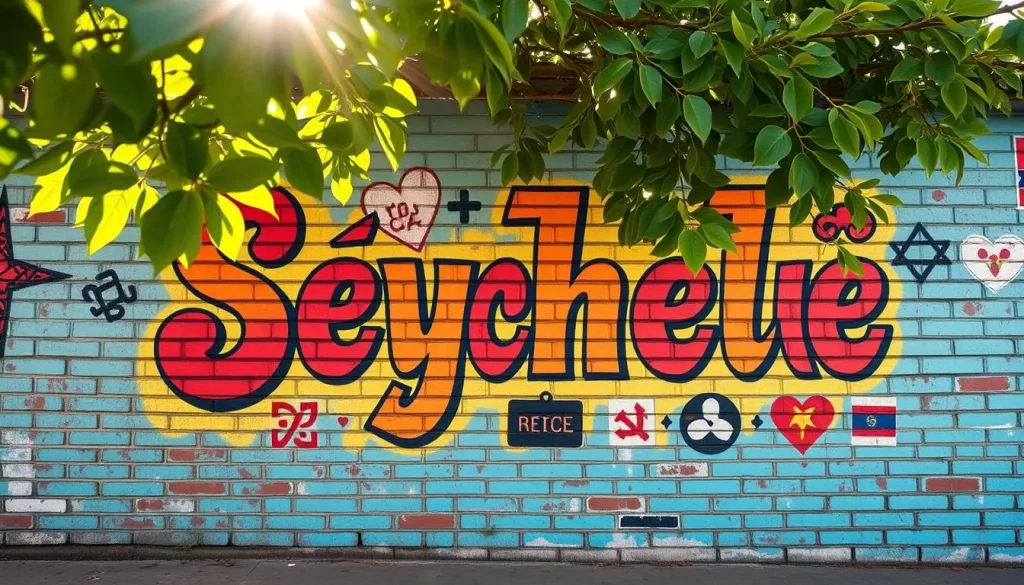
Seychellois Creole: The Heart of Communication
Seychellois Creole, known locally as seselwa or kreol, is the language of the majority. Approximately 95% of the population speaks it natively. This French-based language is the backbone of everyday communication, connecting people across the island.
Its roots trace back to the colonial era, blending French with African dialects. Today, it symbolizes unity and cultural pride. Whether at home or in the market, this language is the heart of daily life.
The Role of English and French in Formal Domains
While Seychellois Creole dominates informal settings, English and French are essential in formal contexts. English is the primary language in government, business, and education. Legal documents and parliamentary proceedings are conducted in English, reflecting its historical influence.
French, on the other hand, is cherished by the Franco-Seychellois minority. It is often used in media and cultural events. Together, these languages create a balanced linguistic ecosystem, bridging informal and formal communication.
This multilingual nature ensures that every person can navigate both casual and official settings with ease. It’s a testament to the country’s adaptability and inclusivity.
Cultural and Social Impacts of Language
Language plays a pivotal role in shaping the cultural identity of this island nation. It’s more than just a way to communicate; it’s a bridge to the past and a marker of belonging. The way people speak here reflects their history, traditions, and values.

Language as a Marker of Identity
For many, the language they speak is a badge of pride. Seychellois Creole, for instance, connects people to their roots. It’s a blend of French and African dialects, born during the colonial era. This unique mix symbolizes unity and resilience.
Historical events, like the abolition of slavery in the 19th century, have left their mark on the language. Words and phrases from that time still echo in daily conversations. They remind people of their shared struggles and triumphs.
On special days, like festivals, the language takes center stage. Songs, poems, and speeches in Creole celebrate the island’s heritage. It’s a way to honor the past while looking to the future.
Interconnections with Religion and Local Traditions
Religion and language are deeply intertwined here. Roman Catholicism, practiced by 82% of the population, influences many aspects of life. Prayers and hymns in Creole bring communities together during religious ceremonies.
Local traditions also rely on the language to thrive. Storytelling, for example, is a cherished practice. Elders pass down tales in Creole, keeping the island’s history alive for younger generations.
Even in everyday life, the language fosters a sense of belonging. Whether at a market or a family gathering, speaking Creole signals that you’re part of the community. It’s a way to connect with others on a deeper level.
| Aspect | Role of Language |
|---|---|
| Cultural Identity | Acts as a symbol of unity and heritage |
| Religion | Used in prayers, hymns, and ceremonies |
| Traditions | Preserves history through storytelling |
Understanding the role of language in education is also crucial. Studies, like those found here, highlight how language policies impact learning and cultural preservation. It’s a reminder of the importance of nurturing linguistic diversity.
Practical Tips for Language Usage and Travel
Navigating the linguistic landscape of this island can enhance your travel experience. Understanding local customs and basic phrases helps you connect with the population and immerse yourself in the culture.

Language Etiquette and Everyday Tips
When interacting with locals, a friendly greeting in Seychellois Creole goes a long way. Start with “Bonzour” (Good day) or “Mersi” (Thank you) to show respect.
Tipping is not mandatory, but a 10% service charge is often included in bills. For exceptional service, a small additional tip is appreciated.
Dining customs are relaxed, but it’s polite to wait for the host to start eating. Public transportation is affordable, with buses costing around 12 SCR (~$0.80) per ride.
Useful Phrases and Communication Strategies
Learning a few key phrases can bridge language barriers. Here are some essentials:
- “Koman ou lé?” (How are you?)
- “Ki manyèr pou al…?” (How do I get to…?)
- “Es ki ou kapab ed mwan?” (Can you help me?)
English is widely spoken in tourist areas, but using local phrases shows effort and respect.
For more detailed insights into the language and culture, check out this comprehensive guide.
| Tip | Benefit |
|---|---|
| Learn basic Creole phrases | Enhances communication and builds rapport |
| Understand tipping customs | Shows appreciation for service |
| Use public transportation | Saves money and supports local economy |
Exploring this island becomes more rewarding when you embrace its language and customs. For additional travel tips, visit this travel guide.
Legacy and Preservation Efforts in Seychelles
Efforts to preserve the linguistic heritage of this island nation are a testament to its cultural resilience. The government, along with institutions like the Creole Institute, has taken significant steps to safeguard native languages. These initiatives ensure that the language remains a vital part of the population’s identity.
Government and Institutional Initiatives
The government has implemented policies to promote and protect Seychellois Creole. In 2021, Moutya, a traditional dance tied to the language, was inscribed on UNESCO’s list of intangible cultural heritage. This recognition highlights the global significance of the island’s cultural practices.
Institutions like the Creole Institute play a pivotal role in codifying the language. The first-ever Creole dictionary was published during David André’s tenure as Secretary General of the Seychelles Institute of Culture, Heritage, and the Arts. This milestone marks a significant step in preserving the language for future generations.
Educational Outreach and Future Prospects
Educational programs are central to these preservation efforts. Schools incorporate Seychellois Creole into their curricula, ensuring that students remain connected to their roots. Interactive workshops engage primary and secondary students, fostering a deeper appreciation for the language.
Community involvement is also crucial. The 40th edition of Festival Kreol, planned for October 2025, celebrates Creole culture and invites global participation. Events like these strengthen national identity and ensure the language thrives for years to come.
For more insights into the cultural significance of these efforts, explore this comprehensive guide.
Conclusion
The linguistic heritage of this island reflects its rich history and cultural identity. Seychellois Creole, English, and French each play a unique role in shaping daily life and national pride. These languages are more than just tools for communication—they are symbols of unity and resilience.
From colonial influences to modern preservation efforts, the evolution of these languages tells the story of a vibrant country. Seychellois Creole remains the heart of local interactions, while English and French dominate formal settings. Together, they create a harmonious blend that defines the island’s character.
Understanding this linguistic diversity enriches your experience when visiting. It connects you to the people and their traditions. For deeper insights into the cultural significance of these languages, explore this study.
This multilingual tapestry is a testament to the country’s adaptability and inclusivity. It invites you to appreciate its unique charm and vibrant culture.
The above is subject to change.
Check back often to TRAVEL.COM for the latest travel tips and deals.
